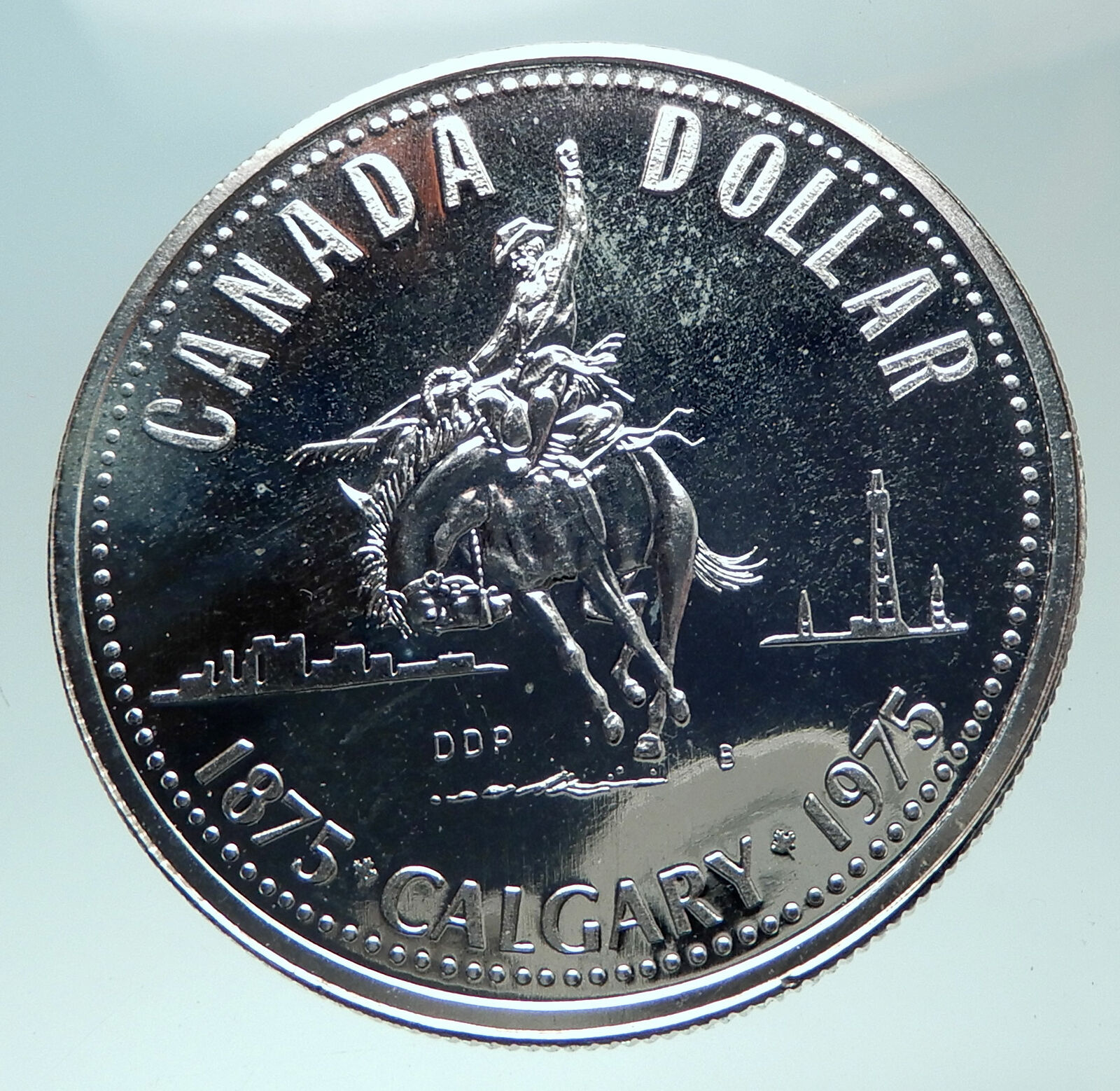|
Canada under Elizabeth II – Queen: 6 February 1952–present
100th Anniversary of the Ottawa Parlimentary Library
1976 Proof-like Silver Dollar 35mm (22.84 grams) 0.500 Silver (.3750 oz. ASW)
Reference: KM# 106
ELIZABETH II D·G·REGINA, Elizabeth II portrait.
CANADA DOLLAR 1876-1976, The Bibliothèque du Parlement d’Ottawa.
You are bidding on the exact item pictured, provided with a Certificate of Authenticity and Lifetime Guarantee of Authenticity.
 The Library of Parliament (French: Bibliothèque du Parlement) is the main information repository and research resource for the Parliament of Canada. The main branch of the library sits at the rear of the Centre Block on Parliament Hill in Ottawa, Ontario, and is the last untouched part of that larger building’s original incarnation after it burned down in 1916. The library has been augmented and renovated a number of times since its construction in 1876, the last between 2002 and 2006, though the form and decor remain essentially authentic. The building today serves as a Canadian icon, and appears on the obverse of the Canadian ten-dollar bill. The Library of Parliament (French: Bibliothèque du Parlement) is the main information repository and research resource for the Parliament of Canada. The main branch of the library sits at the rear of the Centre Block on Parliament Hill in Ottawa, Ontario, and is the last untouched part of that larger building’s original incarnation after it burned down in 1916. The library has been augmented and renovated a number of times since its construction in 1876, the last between 2002 and 2006, though the form and decor remain essentially authentic. The building today serves as a Canadian icon, and appears on the obverse of the Canadian ten-dollar bill.
The library is overseen by the Parliamentary Librarian of Canada and an associate or assistant librarian. The Canadian Parliamentary Poet Laureate and the Parliamentary Budget Officer are also considered to be officers of the library.
The Library of Parliament’s roots lie in the 1790s, when the legislative libraries of Upper and Lower Canada were created; these operated separately until the creation of the Province of Canada in 1841 and the collections were amalgamated and followed the provincial capital as it moved between Kingston, Montreal, Toronto, and Quebec City. The library was to be established in Ottawa after, in 1867, Queen Victoria chose Bytown as the new seat for her crown in the Dominion of Canada, and the Library of Parliament Act formed the institution in 1871.
Though construction of the present library began in 1859 and the collection arrived in Ottawa in 1866, work was halted in 1861 and was not completed until 1876, when the 47,000 volumes-including several donated by Queen Victoria-were installed. Around 1869, the builders discovered that they didn’t have the technical knowledge to build the domed roof, meaning that Thomas Fairbairn Engineering Co. Ltd. of Manchester had to be contracted to provide a pre-fabricated dome within a few weeks; this gave the Library of Parliament the distinction of being the first building in North America to have a state-of-the-art wrought iron roof. Further, in 1883, the library’s 300 gas lights were converted to electricity. However, such additional costs brought the library’s price to $301,812, a sum added on top of the total cost for all the parliament buildings, which had already gone far above the original allotted budget. Within only 12 years, the entire roof was stripped of its slate shingles in a tornado that hit Parliament Hill in 1888, since then the roof has been clad in copper.
The library’s contents grew over the next five decades and were saved from the 1916 fire that destroyed the majority of the Centre Block; the building was only connected to the main complex by a single corridor and the library clerk at the time, Michael MacCormac, secured the library’s iron doors before the fire could spread into that area. Fire eventually broke out in 1952, in the library’s cupola, and caused extensive damage through smoke and water. It was then necessary to perform structural work, as well as to install a replica of the inlaid parquet floor and dismantle the wood panelling and ship it to Montreal for cleaning and partial fireproofing. The Centre, East, and West Blocks subsequently received extensive climate control and electrical upgrades, but the library was largely overlooked.
The deficiencies, plus conservation, rehabilitation, and upgrading, were addressed when a major, $52 million renovation was researched in 1996 and undertaken between 2002 and 2006. Public Works and Government Services Canada contracted the Thomas Fuller Construction Company (operated by the building designer’s great-grandsons) to manage a project that fixed leaks in the roof and crumbling mortar in the walls on the exterior, as well as extensive repairs to the wood and plaster work and the installation of climate control systems on the interior. Also done at the time was a nine metre deep excavation of the bedrock beneath the library building, in order to provide more storage space, mechanical areas, and a link to an existing loading dock. The project used precision survey, laser measurement, photogrammetry, and the then fledgling technology of Computer Aided Three Dimensional Interactive Application. After four years of work, the library was opened to the public, with tours of the library resuming on 5 June 2006, though Thomas Fuller Construction filed a $21 million lawsuit against the Crown for cost overruns.
.svg/220px-Canada_(orthographic_projection).svg.png)  Canada is a country, consisting of ten provinces and three territories, in the northern part of the continent of North America. It extends from the Atlantic to the Pacific and northward into the Arctic Ocean, covering 9.98 million square kilometres (3.85 million square miles) in total, making it the world’s second-largest country by total area and the fourth-largest country by land area. Canada’s common border with the United States forms the world’s longest land border. Canada is sparsely populated overall, the majority of its land territory being dominated by forest and tundra as well as the mountain range of the Rocky Mountains; about four-fifths of the population live near to the southern border. The majority of Canada has a cold or severely cold winter climate, but southerly areas are warm in summer. Canada is a country, consisting of ten provinces and three territories, in the northern part of the continent of North America. It extends from the Atlantic to the Pacific and northward into the Arctic Ocean, covering 9.98 million square kilometres (3.85 million square miles) in total, making it the world’s second-largest country by total area and the fourth-largest country by land area. Canada’s common border with the United States forms the world’s longest land border. Canada is sparsely populated overall, the majority of its land territory being dominated by forest and tundra as well as the mountain range of the Rocky Mountains; about four-fifths of the population live near to the southern border. The majority of Canada has a cold or severely cold winter climate, but southerly areas are warm in summer.
The land now called Canada has been inhabited for millennia by various Aboriginal peoples. Beginning in the late 15th century, British and French colonies were established on the region’s Atlantic coast. As a consequence of various conflicts, the United Kingdom gained and lost North American territories until left, in the late 18th century, with what mostly comprises Canada today. Pursuant to the British North America Act, on July 1, 1867, three colonies joined to form the autonomous federal Dominion of Canada. This began an accretion of provinces and territories to the new self-governing Dominion. In 1931, Britain granted Canada near total independence with the Statute of Westminster 1931 and full sovereignty was attained when the Canada Act 1982 severed the vestiges of legal dependence on the British parliament.
Canada is a federal parliamentary democracy and a constitutional monarchy, Queen Elizabeth II being the current head of state. The country is officially bilingual at the federal level. It is one of the world’s most ethnically diverse and multicultural nations, the product of large-scale immigration from many countries, with a population of approximately 35 million as of 2015. Its advanced economy is the eleventh largest in the world, relying chiefly upon its abundant natural resources and well-developed international trade networks. Canada’s long and complex relationship with the United States has had a significant impact on its economy and culture.
Canada is a developed country and one of the wealthiest in the world, with the tenth highest nominal per capita income globally, and the eighth highest ranking in the Human Development Index. It ranks among the highest in international measurements of government transparency, civil liberties, quality of life, economic freedom, and education. Canada is a Commonwealth Realm member of the Commonwealth of Nations, a member of the Francophonie, and part of several major international and intergovernmental institutions or groupings including the North Atlantic Treaty Organization, the G8, the Group of Ten, the G20, the North American Free Trade Agreement and the Asia-Pacific Economic Cooperation forum.
|





 The Library of Parliament (French: Bibliothèque du Parlement) is the main information repository and research resource for the Parliament of Canada. The main branch of the library sits at the rear of the Centre Block on Parliament Hill in Ottawa, Ontario, and is the last untouched part of that larger building’s original incarnation after it burned down in 1916. The library has been augmented and renovated a number of times since its construction in 1876, the last between 2002 and 2006, though the form and decor remain essentially authentic. The building today serves as a Canadian icon, and appears on the obverse of the Canadian ten-dollar bill.
The Library of Parliament (French: Bibliothèque du Parlement) is the main information repository and research resource for the Parliament of Canada. The main branch of the library sits at the rear of the Centre Block on Parliament Hill in Ottawa, Ontario, and is the last untouched part of that larger building’s original incarnation after it burned down in 1916. The library has been augmented and renovated a number of times since its construction in 1876, the last between 2002 and 2006, though the form and decor remain essentially authentic. The building today serves as a Canadian icon, and appears on the obverse of the Canadian ten-dollar bill. .svg/220px-Canada_(orthographic_projection).svg.png)
 Canada is a country, consisting of ten provinces and three territories, in the northern part of the continent of North America. It extends from the Atlantic to the Pacific and northward into the Arctic Ocean, covering 9.98 million square kilometres (3.85 million square miles) in total, making it the world’s second-largest country by total area and the fourth-largest country by land area. Canada’s common border with the United States forms the world’s longest land border. Canada is sparsely populated overall, the majority of its land territory being dominated by forest and tundra as well as the mountain range of the Rocky Mountains; about four-fifths of the population live near to the southern border. The majority of Canada has a cold or severely cold winter climate, but southerly areas are warm in summer.
Canada is a country, consisting of ten provinces and three territories, in the northern part of the continent of North America. It extends from the Atlantic to the Pacific and northward into the Arctic Ocean, covering 9.98 million square kilometres (3.85 million square miles) in total, making it the world’s second-largest country by total area and the fourth-largest country by land area. Canada’s common border with the United States forms the world’s longest land border. Canada is sparsely populated overall, the majority of its land territory being dominated by forest and tundra as well as the mountain range of the Rocky Mountains; about four-fifths of the population live near to the southern border. The majority of Canada has a cold or severely cold winter climate, but southerly areas are warm in summer.




